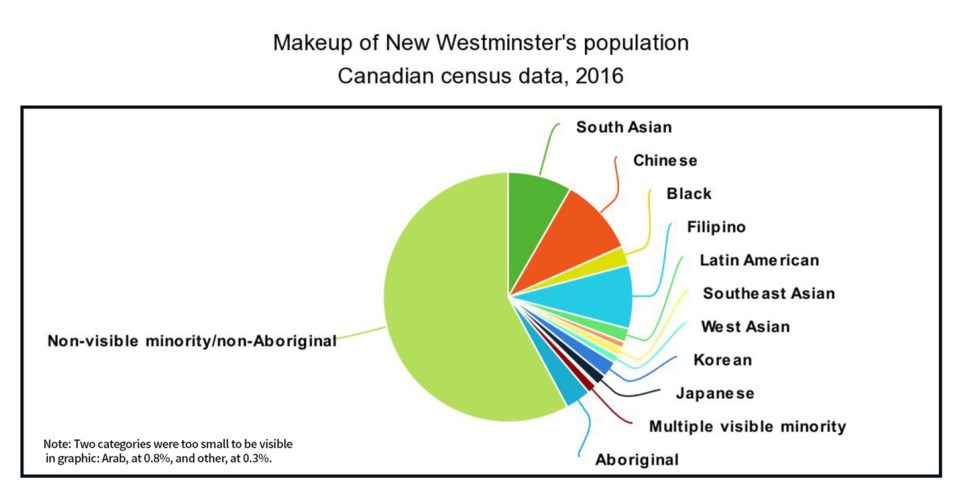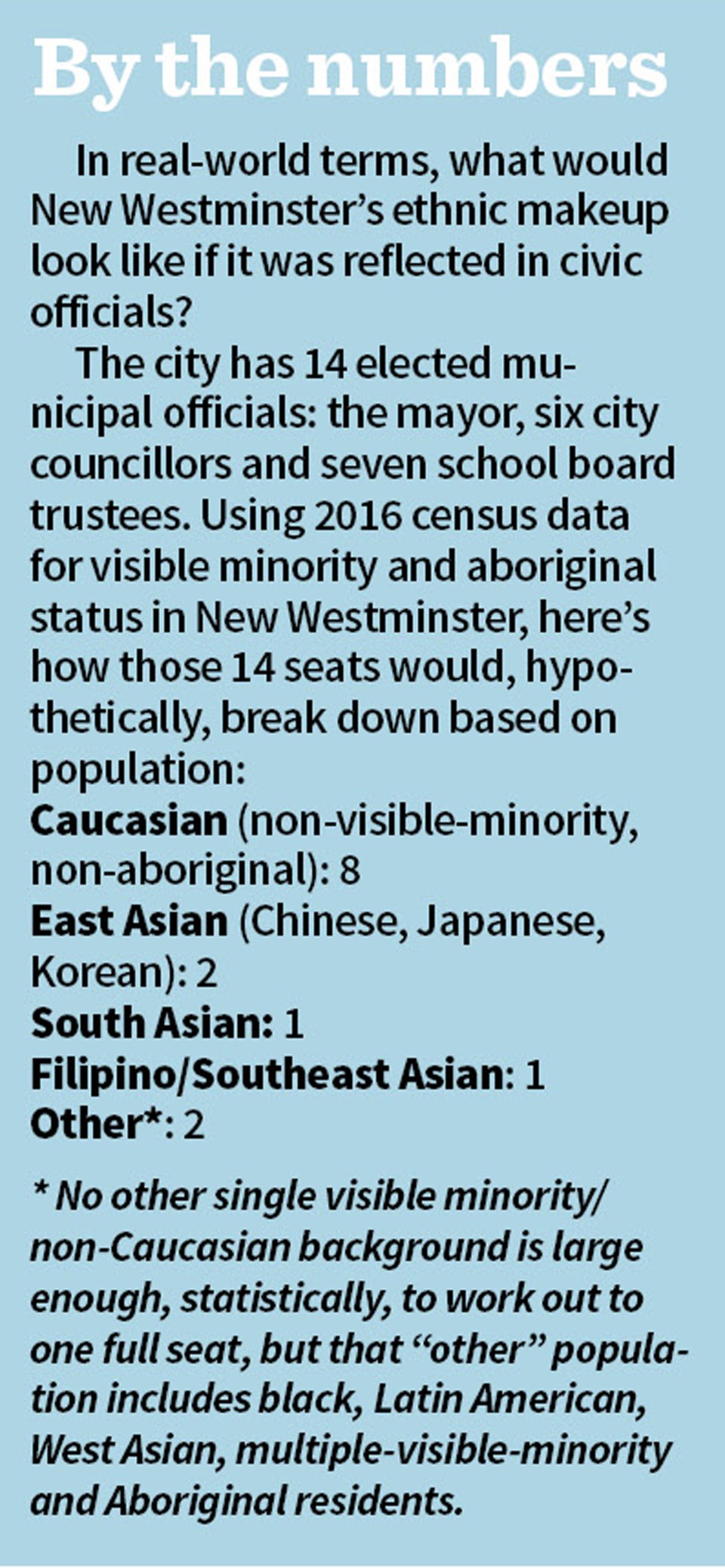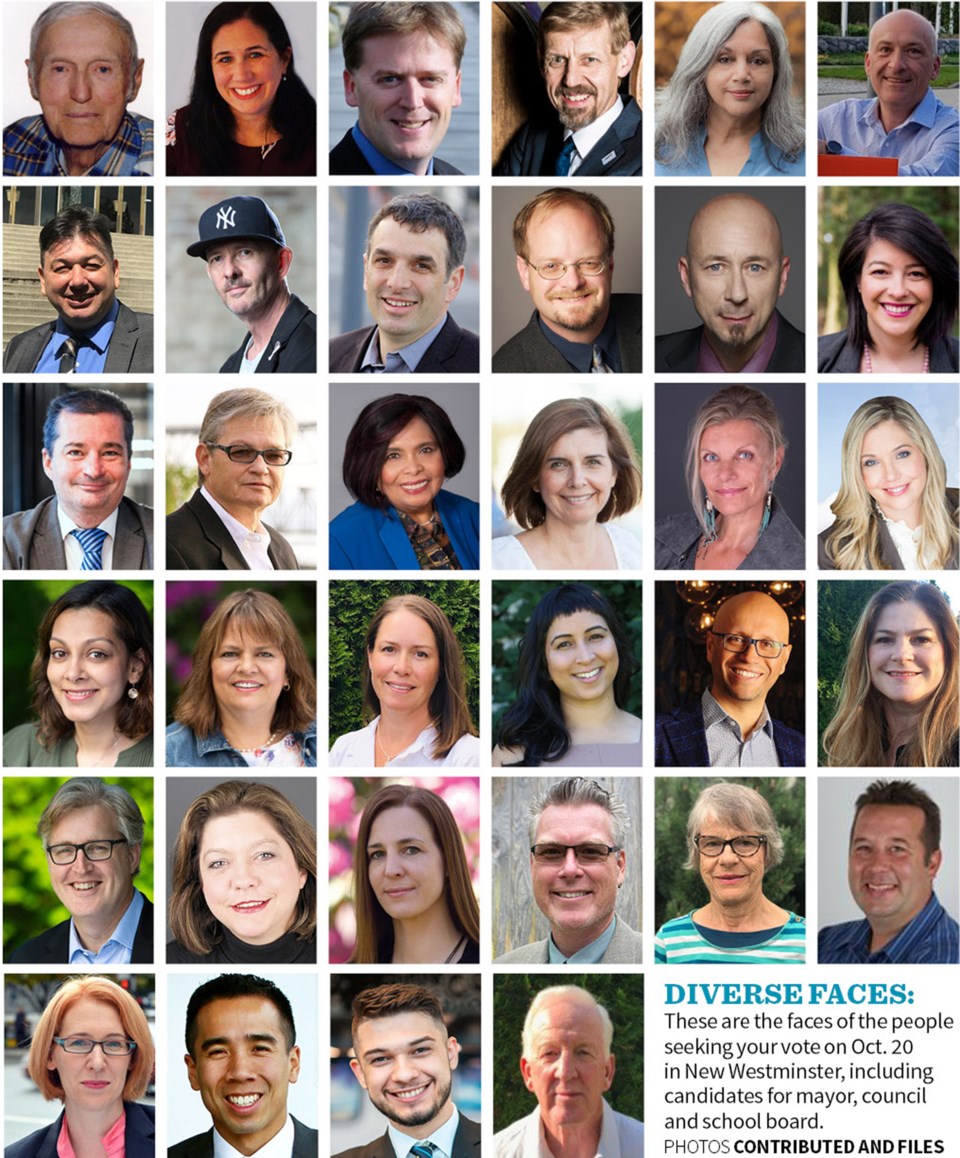Walk around the streets of New Westminster, ride its buses, eat in its restaurants, and, wherever you go, you’ll see the faces of diversity.
Based on 2016 census data (see graph below), 39 per cent of the city’s population is from a visible minority population; taking into account the city’s 3.3 per cent Aboriginal population, that brings the total up to 42.3 per cent “non-white” residents.
Yet that diversity is not reflected among the city’s elected officials; not a single current member of council or school board is from a visible minority population.
This year’s crop of candidates, however, is setting out to change that. And they’re hoping, when the polls close on Oct. 20, city council and school board will look more like the city’s population.
The Record set out to find out just why the issue of diversity has become so important in the 2018 campaign – and what it may mean for citizens of New Westminster.
THE TIME IS NOW
Could 2018 be the moment when it changes?
Troy Hunter, a member of the Ktunaxa First Nation, thinks so. Hunter, who’s running for council as an independent, said it would be “monumental” to elect an Indigenous person to city council.
Diversity, he said, is key for the city in 2018.
“I think it’s really important,” he said. “We are in the age of reconciliation. Back in 1861/1862, New Westminster city council were making bylaws or whatever it was back then to oust Indigenous people from the city limits. I think that’s pretty monumental to have the City of New Westminster actually elect an Indigenous person. That’s getting to diversity, that’s getting to reconciliation.”
Daniel Fontaine, who’s running for council with the New Westminster Progressives, said diversity has been on the agenda for the group since it began its formation a year ago.
“I think it’s important to have that representation of the community reflected in council,” he said.
Fontaine is pleased the coalition has put forward a gender-balanced slate, including a visible minority candidate.
“We need to do more,” he said. “We need to work harder in the next four years and try and ensure we attract an even more diverse group of candidates.”
For Cyrus Sy, who’s running for school board with the New West Progressives, it’s a pretty straightforward issue: city officials should reflect the people they represent.
“I always felt that most elected officials, especially in New Westminster, there doesn’t seem to be a lot of visible minorities,” he said. “One of the values that I have when it comes to government is that I think it should represent the community makeup. In New Westminster, 40 per cent or so are visible minorities. It only makes sense that our elected government reflects that.”
Sy laughs that his own ethnic background is a very particular niche – he’s from Newfoundland, but his parents are of Chinese and Filipino descent. These days, he considers himself very much a New Westminster resident, first and foremost.
“I’m a New Westminsterite who happens to be a Filipino-Chinese Canadian,” he said.
His heritage his important to him – “My parents raised us always to not forget our roots,” he said – but he doesn’t intend to make it a part of why he believes people should vote for him.
“If you look at Canada, everybody is really an immigrant,” he said.
For candidates on the New Westminster and District Labour Council-endorsed Team Cote – which is fielding seven women and five men, including four visible minority candidates – the issue of diversity is front of mind for this campaign.
Nadine Nakagawa, who’s running for council with Team Cote, said she sees a huge change over four years ago.
“There is a lot more diversity, and the quality of the diversity of the candidates is really strong this time,” she said. “I volunteered on campaigns in the last election, 2014, and I think this is a very refreshing change.”
Anita Ansari, a school board candidate with Team Cote, thinks so too. The chemical engineer and mother of two is emotional about the possibilities of having a more representative civic government.
“It’s a really exciting time,” she said. “After so many years, we have so many really exciting minority candidates. I am so grateful and, dare I say it, blessed, to be part of this resurgence. To be part of such a huge shift … I’m going to be telling this story to my grandkids.”

WHY IT MATTERS
So what's the big deal, anyway? Why does diversity matter?
As Sanjay Jeram, a political science lecturer at Simon Fraser University explains it, the answer is a two-pronged one. There’s the philosophical argument, that greater diversity of representation leads to empowerment of minority communities; and there’s the practical argument, that a greater diversity of voices leads to better policy-making. (See related story.)
For Ansari, there’s a very strong pull towards the former: to serve as a role model and to empower other visible minority citizens – particularly young women. Ansari, whose family is from Pakistan, stepped forward to run in part because she attended a meeting at city hall where she saw only a couple of women on council, and no people of colour.
“I have a daughter, and I want her to be able to imagine to be mayor of someplace. Whether she chooses to or not, I want the possibilities to be open for a woman of colour,” Ansari said.
“I didn’t think about a lot of these things until I had a daughter. You don’t really realize these are the boxes that you view around your reality until you have a little person, and you’re trying to make them grow as big as they can be.”
The idea might have only remained a thought in the back of her mind had Ansari not been approached by incumbent councillor Mary Trentadue about the possibility of running. At first, Ansari said, she just listened politely and then went home with no intention of saying yes. But once she told her husband about the opportunity, he reminded her how often she talks about the need to open up options for women of colour.
So she agreed.
Being on the campaign trail has been eye-opening for Ansari – mostly in a good way. What she’s realized, though, is how few people actually know how underrepresented visible minority populations have been.
Ansari’s search led her to only two visible minority trustees in the past: Vasant Saklikar and Cindy Grewal. While that might make sense in smaller towns with mostly Caucasian populations, Ansari said, it makes no sense in New Westminster.
For Ansari, it’s not an issue of whether the existing non-minority officials have done a good job (“I love the council that we have,” she said). What it is, rather, is a case of “they don’t know what they don’t know.”
She uses the analogy of walking to the SkyTrain late at night.
“It’s the end of a dark street and you’re alone. As a woman walking down that street, it’s a lot different than a man,” she said. “As a person of colour, that darkness, that feeling of being vulnerable, expands out to your entire existence in North America.”
Members of visible minority communities need to be there to bring that unseen perspective to the table, Ansari said. And they also need to be there to signal to the wider community that they are an integral part of life in this city.
“My main purpose was to show people that women who are minorities, that we exist out there, that we are doing good things in the world,” she said. “My community needs to know that women like me exist in it.”
That message is especially important to young members of visible minority communities, who may be questioning their place in society and who need to see visible role models, Ansari said.
“I feel like the person I am kind of running for, in my head, is that South Asian 12-year-old sitting there and wondering why everything about her is so different and how she’s going to find her place in the world,” Ansari said. “If I can make life easier for that one girl, that one 12-year-old, then I have met my goal.”
MAKING POLICY

Chinu Das, who’s running for council with Team Cote, has been concerned for decades with the issue of bringing marginalized voices to the table. Das came to Canada from India in 1979 to do a PhD in urban planning at the University of British Columbia, where her thesis was on the topic of people in urban areas being marginalized.
She’s focused on making sure all New West residents “are heard, are represented and can participate.”
“That is important to me just because the numbers of newcomers and visible minorities is growing in New West,” she said.
Das thinks having more visible minorities in office might encourage people to get involved in the workings of the city.
Das took the microphone at a recent all-candidates meeting to note that, while nearly 40 per cent of the city’s population is visible minorities, their voices are not being heard at city hall or at committee meetings.
“My statement at the all-candidates meeting was because I am going to city council, and a lot of the decisions made by city council on housing and traffic and the amenities that it is providing – all those hard-core issue areas in city governance – they need input from everybody,” she said. “If they don’t, and if the people are not hearing what these all-candidates debates are about, they are not weighing in. That concerns me.”
For Nakagawa, there’s a clear correlation between more diverse representation and better policy making.
“The biggest point for me is just that we will have better policy if we have more voices at the table and a better representation of our community. It will make the city better for everyone,” she said.
Nakagawa said people from diverse backgrounds will be able to bring their “lived experience” to city council and school board, hers being that of a millennial woman of Japanese descent.
“I am quite startled that I am the only millennial running for council – and I am barely a millennial, too – in a city that the demographic has been shown to be changing since the last census results came out,” she said. “I think it’s that lived experience and that valuing of more voices, that I haven’t seen someone who looks like me represented.”
Nakagawa believes seeing more women and more cultures represented on council would have a positive impact on the level of public engagement in the city.
“But, more than that, it is capturing the knowledge and experience of the folks, on how to reach out to different communities and be a little bit more mindful on different ways to engage.”
THINK INCLUSION
Angela Sealy, who’s running for council as an independent, says in a city as diverse and open as New Westminster, diversity will come – if we put the focus on inclusion.
“If you put inclusion first, diversity works,” says Sealy, who was born in Barbados and came to Canada in 1967. “The reality is, even within your own family, your brother is not the same person you are; your sister is probably not the same way. You have diversity within your home. I would say skip over that and start thinking inclusion. Inclusion all the time.”
Sealy says efforts to increase engagement from people of more diverse backgrounds require more than electing people from different ethnic backgrounds and genders. She points out that, in some cases, people have come to Canada from countries with completely different political systems that may make them fearful of voting, so education is key to getting people involved.
Sealy said that, if she were to get elected, she would like to have a committee based in the community that talks about democracy.
“I want to make a concerted effort to bring those folks in. When I say ‘those folks,’ I mean everybody. People who were born here, people who were born anywhere,” she said. “It’s much deeper. It’s wonderful to talk about these things and diversity. We need to get beyond that. We need to go deep and find out what it is that would bring you out, what do you need from us to bring you out?”
WHO’S DIVERSE?
Fontaine noted a person’s name or appearance doesn’t necessarily convey everything about them. For instance, he noted, his team’s campaign manager is Nancy Graham – a Chinese-Canadian with what is typically assumed to be a “Caucasian” name.
Fontaine said people may also be misled by his own Caucasian appearance. In fact, he’s among the 1.3 per cent of New Westminster’s population that’s Métis.
“I first and foremost identify as being francophone, and then I identify myself as being Métis,” he said. “I am very proud of that, but most people don’t know because I have no accent. I don’t visibly look like I come from a minority group, so, therefore, they assume that I am kind of a middle-aged white guy.”
It isn’t something that has come up in the campaign before now.
“I didn’t go out publicly and talk about it at all-candidates debates. I am proud of it. It is part of who I am, and my son knows about it. It’s just not something we go out and talk about too much.”
Moreover, the candidates agree the issue of “diversity” goes beyond just race.
For Sy, it’s also equally about the backgrounds and viewpoints of candidates: “not just culture, but diversity in terms of skills and experience, even from a political standpoint; diversity when it comes to political leanings.”
Das, too, is conscious of the number of ways “diversity” needs to reflect marginalized groups.
“I am a senior, and I feel that there is a tendency to create groupings. People who have mobility challenges or the LGBTQ community – anybody who is different in any shape or form needs a little bit more attention.”
Nakagawa, too, is quick to note other areas of diversity that are often overlooked.
“We have a very, very vibrant Pride/LGBTQ community, and we are not seeing that represented,” she said. “Ability is one that often gets forgotten, and it’s very critical that both city council and school board trustees have an awareness of those issues, because it really impacts people.”
Nakagawa has a vision of what an ideal, diverse council would look like.
“It’s one that looks like and reflects our city,” she said. “It’s having people with different housing statuses. It’s people with different abilities, a better gender balance, and people from the cultural backgrounds that are represented in our community.”
Fontaine said change won’t happen without effort.
“This doesn’t come naturally,” he said. “You have to work at it as a city government, as a provincial government, as a federal government, to make it happen. That’s the heavy lifting. That’s the harder part to do. I think we can do a better job at it for sure.”
Fontaine said it’s important that council, school board and every other elected body reflect the community.
“We have watched it evolve over time,” he said. “The leader of the federal New Democratic Party wears a turban and is with the Sikh community. We may not have seen that 20 or 30 years ago. We are evolving in our politics.
“I would love to get to a day where we don’t even have to identify with that, that it’s just a normal part of people coming from various communities, various cultural backgrounds.”



